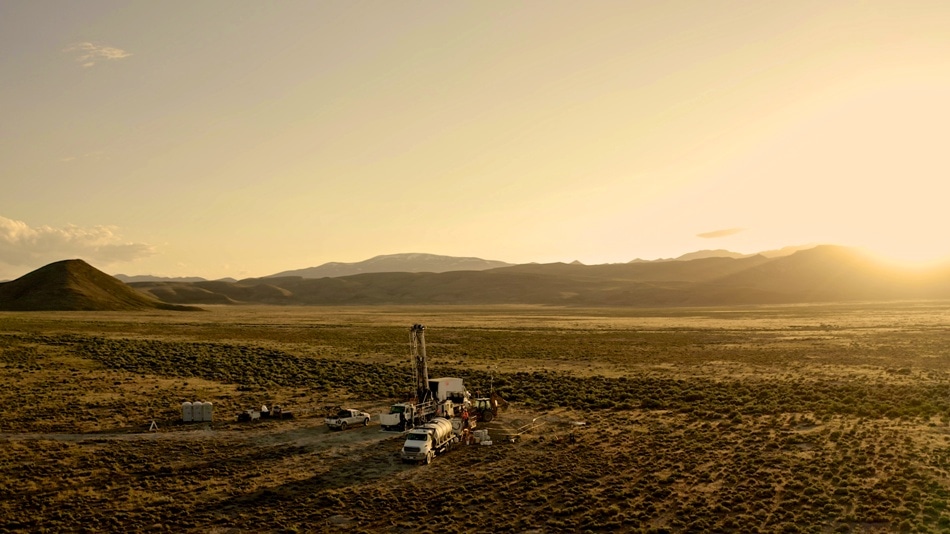Jun 28 2019
Nevada Exploration Inc. takes pleasure in offering an update to its stakeholders on its June 2019 exploration activities.
 Drill hole SGVC010 at South Grass Valley Project. (Image credit: Nevada Exploration Inc.)
Drill hole SGVC010 at South Grass Valley Project. (Image credit: Nevada Exploration Inc.)
From the time it started its 2019 field program at South Grass Valley (the “Project”), the company has finished drill hole SGVC009 to a depth of 621 m. It is now drilling hole SGVC010, located 500 m northwest of SGVC009.
After preliminary logging, it has been corroborated that the important Carlin-type geologic features observed in NGE’s previous drill holes extend northward beyond the Phase 1 drilling area limits. It has also been established that SGVC009’s bottom consists of the most intense multi-phase silicification and secondary pyrite observed at the Project to date.
We’re off to a great start. Our Phase 1 drilling established we have a large Carlin-type hydrothermal system at the Project, along with a characteristic gold and pathfinder budget. The next step in systematically advancing and derisking the Project is to establish places where geologic conditions may have provided suitable catalysts, or controls, to focus the deposition of gold to form higher grades.
Wade Hodges, CEO, Nevada Exploration Inc.
Wade Hodges continued, "Not only did SGVC009 bottom in the best-looking rocks we’ve seen so far in terms of the type and degree of alteration they contain, importantly, we’re also now seeing abrupt transitions in alteration minerals and textures coincident with abundant secondary pyrite veining, which are indicative of the sorts of rapid changes in solution chemistry that are often associated with zones of efficient gold deposition."
With such positive encouragement from SGVC009, we’ve stepped to the north again with SGVC010, and this time will be working hard to get the drill hole deeper to collect more information from these highly prospective units.
Wade Hodges, CEO, Nevada Exploration Inc.
As explained in-depth in the company’s news release dated May 16th, 2019, based on the Phase 1 drilling results, NGE has created a geologic model domaining the Project into smaller target areas, and indicates there is considerable potential to recognize additional targets.
Powered by this model, NGE’s program for its existing exploration phase is to make use of a combination of reverse circulation drill holes, diamond core drill holes, and soil sampling to add geochemistry, geologic, and stratigraphic information, both inside and beyond the limits of its recently concluded Phase 1 drilling program. The goals are (1) to establish the size and extent of the mineralized Carlin-type hydrothermal system at the Project and (2) to prioritize targets for infill drilling.
The SGVC009 drill hole is situated 600 m north of the northernmost Phase 1 drill holes, underneath coincident mercury-in-soil and gold-in-groundwater anomalies along the NNW projected extension of the Carlin-type system found out at the time of the Phase 1 program.
SGVC009 accessed lower-plate bedrock at 412 m, containing finely laminated, interbedded limestone and mudstone units of the Roberts Mountains Formation, underneath a series of alluvium on top of tertiary-aged ash-flow tuff, mudflow breccia, and other ash-fall sediments that consist of highly silicified boulders possibly drawn from adjacent source regions.
Starting at a depth of 487 m, the lower-plate units displayed highly bleached, argillized, and decalcified thinly laminated silty limestone suggestive of vertical chemical zonation, which at 570 m suddenly transitioned to ample brassy late-stage pyrite blebs, black sooty pyrite, and stringers contained in a vuggy, shingle breccia texture exhibiting increase in silicification with depth, which supports evident vertical zonation.
Significantly, volume loss accompanies the pyritic silicification and is commonly related to gold mineralization in Carlin-type gold deposits. Secondary pyrite and silicification continuously increased in intensity with depth; but challenging drilling conditions forced NGE to abandon the hole at 621 m on day 32 of drilling SGVC009.
On the basis of early logging, the sooty pyritic silicification observed at SGVC009 bottom is similar to that observed at the bottom of holes SGVC002, SGVC004, SGVC006, and SGVC007. Currently, these holes together cover an area measuring more than 3 km in strike. At present, all SGVC009 core samples have been submitted for assay.
Monitoring the observable increase in secondary pyrite and silicification noticed toward SGVC009 bottom, at the northern limit of the holes drilled until now, NGE moved another 500 m to the northwest for the SGVC010 drill hole. In order to eliminate the drilling challenges experienced in SGVC009 and to maximize the odds of completing SGVC010 deeper into the prospective stratigraphy, NGE has cased SGVC010 down to 323 m, into what is considered to be the beginning of the lower-plate units, and is now continuing to core drill the hole.
Apart from the core drilling program, the follow-up soil-mercury sampling program by NGE is well in progress, adding extra sample coverage at both the southern and northern ends of the Project. NGE has not yet started its expected Scorpion drilling program as the focus of its field personnel is on supporting the core drilling program.
South Grass Valley Project
NGE’s South Grass Valley Project is a covered (blind) gold exploration project situated nearly 50 km south-southwest of the Cortez complex operated by Nevada Gold Mines (joint venture between Barrick Gold Corp. and Newmont Mining Corp.), inside the specific region of north-central Nevada known to host world-class CTGDs.
NGE originally recognized and staked the Project on the basis of increase in concentrations of gold and CTGD pathfinder elements in groundwater discovered by the Company at the time of a generative basin-scale hydrogeochemistry-supported exploration program. From the time NGE acquired the Project, it has completed detailed air magnetic and gravity geophysics surveys, an in-fill borehole groundwater sampling program, a soil geochemistry sampling program, and most recently, a Phase 1 core drilling program.